Prepper Supplies
Trash Can Emergency Survival Kit List
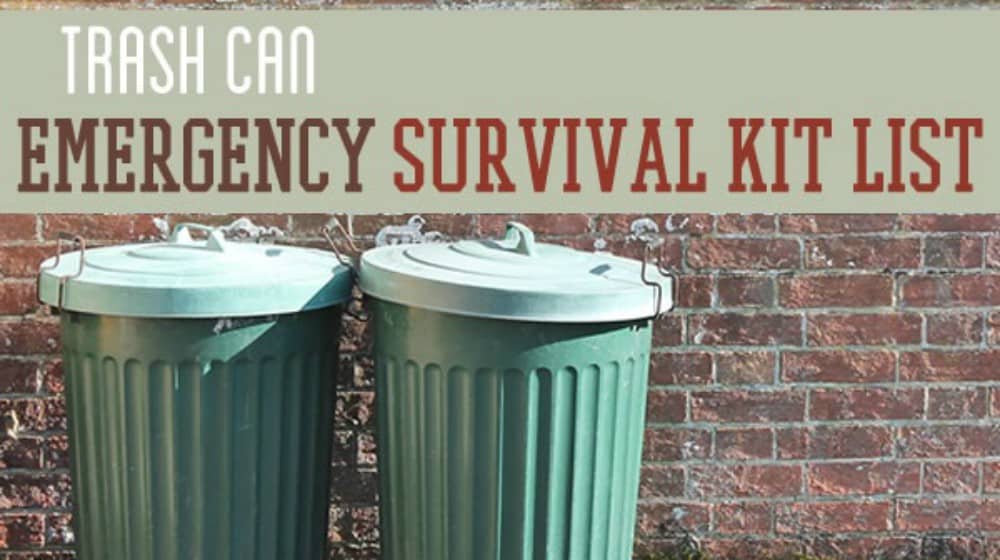
Everyone should have an emergency survival kit on hand in case of an SHTF situation. Because making these survival kits is so popular, there are all different kinds of lists and types of kits out there you can create.
The problem is fitting everything you need to survive in an emergency kit that is still easy to grab if you need to get out of dodge.
Use our trash can emergency survival kit list and tips to strike the perfect balance between having all of your necessities and still staying portably prepared.
Emergency Survival Kit and Supplies in a Trash Can!
Start with Your Container
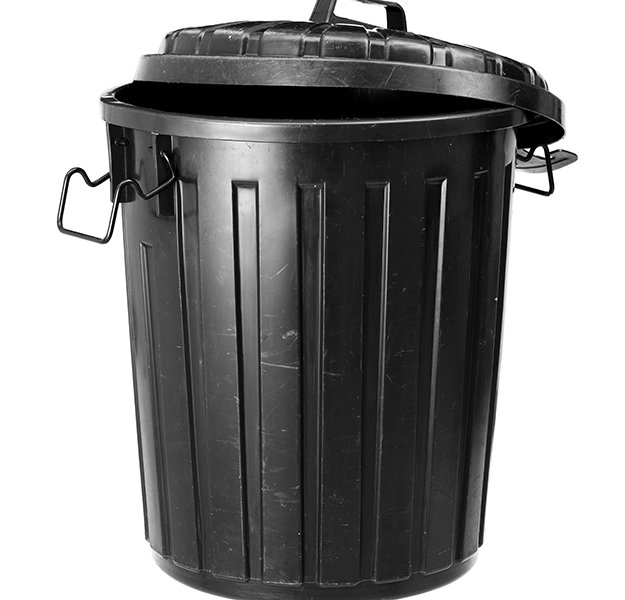
A large trash can works nicely for this kit. It’s large enough to fit everything you need but portable enough that you can take it with you in the event that you need to leave your home in an emergency situation. I would recommend one in a heavy plastic. You want it lightweight and rugged at the same time. There are some metal cans that might work, but with plastic, you never need to worry about rust or corrosion.
You’ll want a lid that snaps securely into place so that in the event that you’d need to transport your kit. all of your supplies will stay safely inside. Imagine loading your kit up in a truck bed only to take a sharp turn, spilling the contents of your trashcan. Not only could you lose items, but you could also do some serious damage jostling your supplies around like that. Keep a lid firmly on your can and avoid this hassle.
What You’ll Need In Your Emergency Survival Kit Checklist:
1. Food and Water
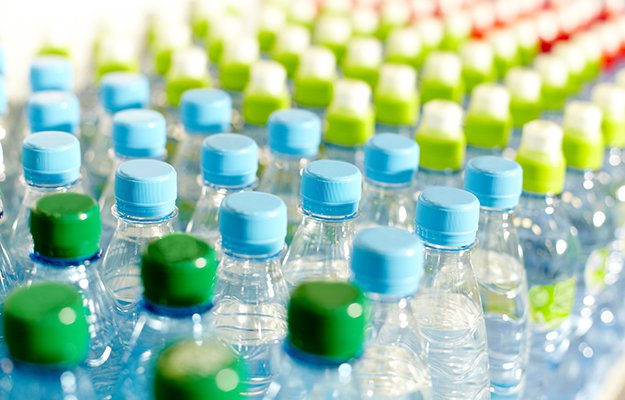
You should have a 3-day supply of food and water. You’ll want one gallon of water per person per day. You don’t want to be stuck without enough water. Especially in a situation where you may have to be exerting yourself physically more than usual.
For food, you’ll want to stick with non-perishables. I recommend canned food as they last a long time and are very convenient. As far as what to get, that’s up to your tastes. Just be sure to get plenty of proteins and nutrient-rich foods to keep your body fueled up. Obviously, you’ll be needing a can opener as well. Consider the dietary restrictions and needs of those in your group when creating this list.
2. First Aid Kit
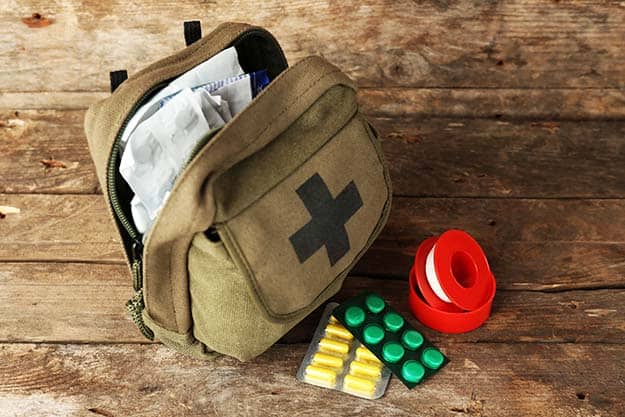
First Aid Kit Photo by Survival Life
You’ll want a standard first aid kit that has everything you need to sanitize and mend all sorts of wounds. Pack up your favorite bandages, antibiotic ointment, gauze, and anything else you like to use to fix up nicks and scratches.
You’ll also want to add sunscreen to this kit, as well as some other medications. Pain reliever, antacid, laxatives, and anti-diarrhea medication should all be in your kit.
A first aid reference book would also be a great thing to keep on hand in case of an emergency.
3. Survival Tools and Gears

You’ll need some extra items in your kit as well for practical purposes. Add these tools and you should be set!
- flashlight
- multi-tool
- duct tape
- compass
- map
- matches
- aluminum foil
- radio
- batteries
This is another portion of the list that takes some thinking. Where will you likely be? What will your days look like? What will you need? Consider these things and add whatever else you’ll require to your survival kit.
4. Sanitation Essentials
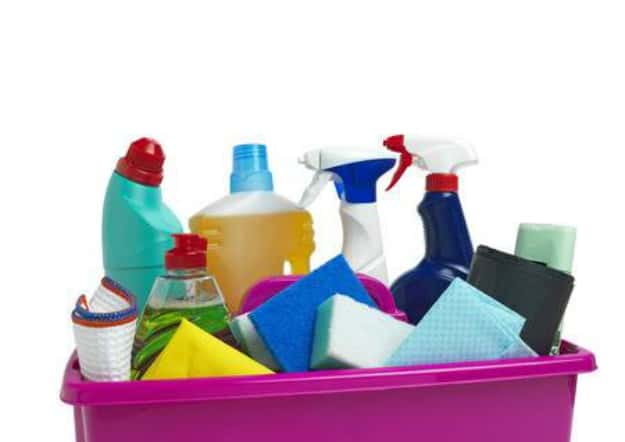
Toilet paper, soap, personal hygiene items, detergent, bleach, and trash bags should also be in your kit.
5. Clothing/Bedding
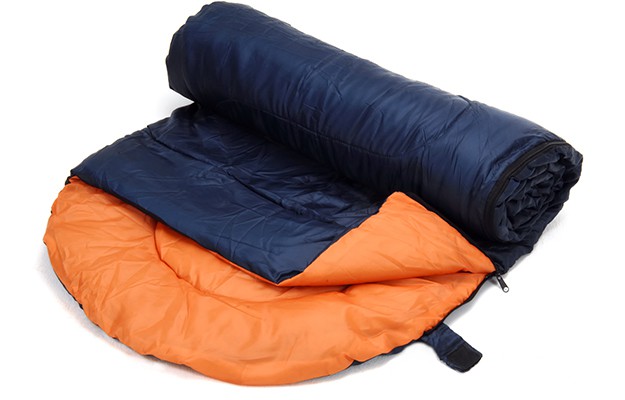
This depends highly on where you’ll be in the survival situation and what time of year it is. You won’t need a parka in Florida and you won’t need rain gear in Arizona. Go with your best judgment when it comes to what to pack for clothes and bedding.
You’ll definitely need a change of clothes for all of those in your group and enough bedding to keep everyone comfortable in your climate.
6. Extra Essentials
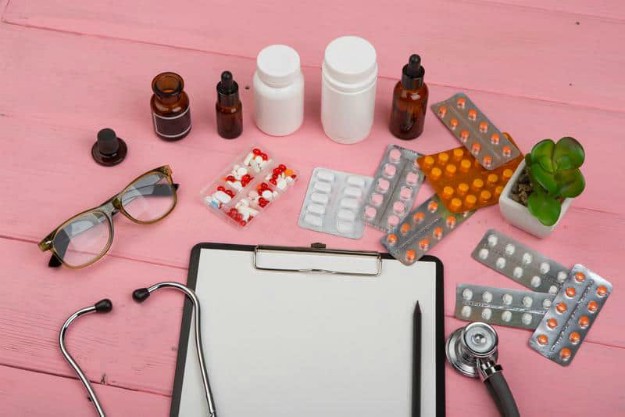
Consider who will be in your group in a survival situation. Consider the ones with special needs when planning for your emergency survival kit. Think about what each person in your party needs to live on for several days. Thinking about the individuals rather than the group could help you remember some important items you’d otherwise forget.
Some examples of these special items:
- Eyeglasses and contacts
- Prescription medications
- Denture supplies
- Baby formula, diapers, etc.
- Diabetes supplies
- Pet food, etc.
Packing Your Supplies
Start with the water, placing your containers at the very bottom of your kit. This keeps the rest of your supplies safe from water damage in the event of one of your bottles springing a leak.
From there, you go from heavy to light with your items. The heaviest, least breakable items should go on top of your water. Don’t put anything too sharp that might puncture the containers and avoid putting anything that might rust too close to the water. Hopefully, you’ll have no broken containers, but just in case, keep your metal away if at all possible.
Moving towards the top of your container, you should be adding lighter and lighter things, saving the most delicate for the top. Be careful not to break your delicate things when putting the top on your trashcan. Keep your extra shoes/clothes on top for easy access in the event of needing to quickly change attire for travel.
For the full article, click here.
Learn how to build a survival kit in this video from Black Scout Survival:
This emergency survival kit should work perfectly for long-storage and for floods or hurricanes. For last minute preparations, you can just easily throw stuff you need into the bin and secure it fast.
How is this information helping out in your emergency survival kit planning? Do you have anything else to add? We’re eager to see your ideas in the comments section below!
Up Next: 377 Survival Hacks And Skills You Should Know
For awesome survival gear, you can’t make at home, check out the Survival Life Store!
Follow us on Facebook, Instagram, Twitter, Tumblr, and Pinterest!
Disclaimer: The contents of this article are for informational purposes only. Please read our full disclaimer.
Editor’s Note: This post was originally published on April 14, 2014, and has been updated for quality and relevancy.
-

 Do It Yourself7 months ago
Do It Yourself7 months agoParacord Projects | 36 Cool Paracord Ideas For Your Paracord Survival Projects
-

 Do It Yourself9 months ago
Do It Yourself9 months agoHow To Make Paracord Survival Bracelets | DIY Survival Prepping
-

 Do It Yourself9 months ago
Do It Yourself9 months ago21 Home Remedies For Toothache Pain Relief
-

 Do It Yourself10 months ago
Do It Yourself10 months agoSurvival DIY: How To Melt Aluminum Cans For Casting
-

 Exports8 months ago
Exports8 months agoAre Switchblades Legal? Knife Laws By State


Diane
April 14, 2014 at 8:22 AM
I have to say that there are times when you will want a rain parka or at least a poncho in Arizona. It does rain there and it can rain hard. One reason people need to carry flood insurance in desert areas is it can flood and flood very quickly.
Jenny Mader
April 14, 2014 at 9:14 AM
Well, why not use a tote. This is just thrown in there in no organized way plus a trash can can’t stack easily. Totes would be a much better container to store survival gear in.
Chuck Cochran
September 1, 2018 at 11:46 AM
My thoughts too Jenny, we have our totes separated and numbered even for order of transfer/importance and stacking. Totes with latching lids require less space in the back of you bug out vehicle or storage area. Manhandling a 40 or 55 gallon Trash can around when it’s full of 75 to a 100+ pounds of gear is asking for problems IMHO, back pain at the very least.
We keep our totes in a set up area under our basement stairs. They’re behind paneling that matches the rec room, so even a home invasion wouldn’t find them without tearing down walls. A few turns of hidden tamper resistant screws and they’re accessible for use or replenishment checks. This is also where we keep our bug in extra supplies.
Dan
April 14, 2014 at 10:45 AM
One thing I never see mentioned in a bug out bag or trashcan are pillow cases. When I used to go hiking when I was much younger I would always take 2 pillow cases. One I would use for it’s intended us but fill it with leaves. If it’s winter and you can’t get green leaves I use my extra clothing to fill the pillow case. The reason for two is because I found myself using the pillow case to collect kindling. It also works good as a water filter to remove sediment.
Desert Fox
April 14, 2014 at 11:02 AM
Loved this article. However, have a personal experience to contradict one of your suggestions. Do not put containers of water in the container. I had a great garbage can with everything I needed for an emergency and it was in the garage with an easy access. Although I keep that room heated…in an unexpected power outage during the winter, the water (at the bottom) froze and the bottles exploded passing moisture to everything inside! I did not discover this until a few months had passed so a lot of my canned goods were rusted, there was mold everywhere and I lost a lot. I recommend you do your water elsewhere.
Myra
April 14, 2014 at 11:13 AM
Maybe the water could first be placed in a large trash bag and sealed. I also think if one could find one of those round plastic tables that would fit down in the trash can, the legs could be cut off to fit over the water containers without squashing them. Then anything placed on top of that would not affect the plastic water bottles.
Chuck Cochran
September 1, 2018 at 12:15 PM
Water Should Always Be Stored Separately From Other Goods! Keeping your water separate is just plain common sense, to do otherwise is asking for problems. It’s the type of lesson we learn that most of us have to experience at least once before we learn it, It’s also one which a lot of these articles neglect to mention, and so folks take it as gospel, until they find out otherwise.
I’m not a fan of the Trash Can Plan as I call it. Trash cans waste a lot of space by themselves, and leave a lot of empty unused space inside just by their design. Full, they’re unwieldy and difficult to move or stack. I prefer Sportsman’s Totes. Rectangular, Locking or latching lids, O-Ring Seals and much more sturdy and impervious than a Home Depot Trash Can will ever be. Online, they cost but a few dollars more than a Trash Can. I use the 20 gallon size as a start. Each is numbered for importance and specific for loading and storage. Water, Canned Goods, Dry Goods, Freeze Dried, Toiletries, Clothing and so forth have their own designated tote. Easier to move, easier to access, and easier to re-provision. They all nest nicely in my storage area or in the back of my vehicle.
To each his/her own, but I’ve been prepping for 40+ years, so I take a lot of these articles with a grain of salt. Sure, there’s some new good ideas, but there’s a lot of garbage out there being passed out too. Use your best weapon, your mind, and research, try it in practice if you can, and discard the trash (can) that’s of little use or outright dangerous.
TSgt B
April 14, 2014 at 11:15 AM
I’d modify your packing instructions thusly:
Since you recommend taking canned food, put the cans on the bottom layer. By having the heavy cans on the bottom, you add ballast (read that: stability) to the can. Put your water on top of the cans (even if it leaks, it should not affect the canned goods, providing you’re a good little prepper and do regular and frequent gear checks. Store everything else in large, “ZipLoc” bags. Double bag, if needed.
Also, consider including a survival firearm or 2 (AR-7, Ruger MKI, II, III) and several hundred rounds of .22 lr.
skip
September 1, 2018 at 5:48 PM
………..or something larger, like in .308
Irish-7
April 14, 2014 at 12:11 PM
We gave away Crisis/Disaster Buckets as Christmas presents in 2012 to our family members that were unlikely to stock emergency supplies. I will try to attach the list below, but I am not sure how much space that I have to comment:
CRISIS GIFT BUCKET
1. LOWES 5 GALLON BUCKET WITH LID
2. BOTTLED WATER – 16.9 oz, I per person in group buckets, 2 per for single recipients.
3. SURVIVAL CANTEEN – Containing: 10 band-aids, whistle/compass, flashlight with AA batteries, space blanket, poncho, D-ring, mini pocket knife and a box of waterproof matches.
4. TOILET PAPER / WET WIPES – Roll of Cottonelle and small pack of generic baby wipes.
5. HATCHET – small
6. SURVIVAL KIT – Containing: Waterproof case, band-aids, whistle, candle, flashlight with AA batteries, mini multi tool and a box of waterproof matches.
7. SLINGSHOT – small with a bag of ammo (ball bearings).
8. FOLDING SAW – 9” Locking blade.
9. DROP CLOTH – Plastic. Use for shelter.
10. LOCK BLADE KNIVES, LIGHTER, WATER PURE TABS, SLINGSHOT CORD- In baggie.
11. TRAVEL KIT – MALE & FEMALE, includes deodorant, toothpaste, toothbrush, soap, etc. Also, a tissue pack and 2 oz bottle of hand sanitizer. All items secured in a ziplock baggie.
12. DUCT TAPE – Roll of gray.
13. FOOD – GRANOLA BARS, SOS FOOD BAR, FRUIT SNACKS, TRAIL MIX
14. PONCO – Lightweight
15. SPACE BLANKETS & SAS SURVIVAL GUIDE – (There is a blanket in the canteen).
16. ELECTRICAL TAPE – 1 Roll
17. SMALL FIRST AID KIT – Just a few band-aids, antiseptic wipes and some moleskin
18. CANDLES & MATCHES – In a ziplock baggie.
19. SURGICAL GLOVES IN A ZIPLOCK BAG
20. HAND/BODY WARMERS – Disposable, 10 hour duration
21. PARACHUTE (550) CORD – About 15 feet.
Left Coast Chuck
April 14, 2014 at 1:40 PM
We have stored our camping/survival gear in plastic tubs for at least 15 years. Plastic tubs have the same advantages of a trash can and because they are smaller, you can divide up your gear so that you have like items with like and don’t have to root through the whole can to get to your water. On that note, I want to state I am not employed by Costco and have no financial interest in that company at all. This weekend I was in their local store and they had very sturdy plastic tubs for less than $9.00. I considered buying them to replace the less sturdy ones I am presently using. The only thing that made me hesitate was the fact that the lids are brilliant yellow and in a bug-out situation, too flamboyant for stealth mode. I am going to check plastic paint today and see if they can be painted. If so, I will be adding them to store my b.o. supplies. They are about 22 gallon, a nice size. They nest quite nicely and have places where you can secure the lid either with a lock or with a rope to fasten two or more together.
cindy
June 4, 2014 at 9:15 AM
Maybe marine deck paint would work. Seems that’s what I recall using, years ago to paint a big tire for a sandbox for our kids. There is also a paint that works on rubber (sorry, can’t recall the name); I used it on some deck shoe sole edges for period costume footwear.
And regarding using totes, the plastic can get brittle and break within a year, in a hot climate. I have a number of totes that are now lidless because of this; and they weren’t even all stored in the garage. The cheaper ones get brittle faster.
D D
June 20, 2018 at 3:32 PM
Problem I have with plastic tubs is that we have rats, squirrels and raccoons who like to chew through if they smell food. Metal cans are better for us.
Chuck Cochran
September 1, 2018 at 12:33 PM
Depends upon the Tote. Sportsmen’s Totes (like Planos) are made of the same plastic as most trash cans, they’re UV and weather resistant. I have some that are 20+ years old and except for style design, you’d be hard pressed to tell them from the ones I bought last fall. I also buy and keep on hand, PA156/157 81mm surplus mortar round cans. Bead blasted and repainted with epoxy enamel, inside and out, they are pretty indestructable as well as impervious to the problems inherent with plastics. After repurposing/refinishing, they can also be buried. I have a couple that have been in the ground since before Obutthead came into office. Checking them this spring, they’re still 100%, as were the supplies stored inside. Watch the surplus stores and you can pick up the mortar cans for around $18 a unit. One of my buried cans has an AR 15, in 2 pieces and a 1000 rounds of M193, they’ve been in the ground since 2007, and are rust/corrosion free still.
tom
April 14, 2014 at 9:16 PM
consider metal trashcan to protect electronics from emp with same storage space and additional prep of faraday box
Gloria in Arizona USA
April 14, 2014 at 10:53 PM
I thought it was interesting that you assumed that you wouldn’t need rain gear in Arizona. NEVER ASSUME. We have the monsoon season which in this area is rain for about two to three months in down pours off and on. We can get up to 2 inches of rain with one storm. NO RAIN GEAR means you and your stuff will get a soaking, so perhaps you might want to say light gear that you can layer.
ANd some type of relief items like Bible, card game, can ease the jitters.
Charlie Brown
April 14, 2014 at 11:53 PM
A great list/summary for someone who is fleeing. My 83-year-old wife is nearly immobile, and at the same age am no longer fit for the Eagle Scout thing. So, for us, it’s stay at home short of a fire (we had one), hurricane damage (had that), tornado (not often in WNC) or flood (had that one, too). How about an article for those of us who aren’t able to GOOD?
Charlie Brown, Hendersonville, NC
Charlie Brown
April 15, 2014 at 12:30 AM
Couple of further thoughts. Most fast food places — MickeyD, Hardees, Carl Jrs. etc. — get their pickles in two-gallon food grade plastic buckets with lids. (My daughter is an asst. mgr of a MacDonalds), and they either recycle or toss them when empty. They would probably give them to you do get rid of them, and they would store a lot of things. Seal the lids with duct tape after filling, and label them.
CB, H-ville
Left Coast Chuck
April 15, 2014 at 3:14 PM
Pickle jars make good storage, but be sure to wash them and let them soak at least overnight with a baking soda solution otherwise everything you put in them will smell and taste of pickles.
Pingback: How trash cans could save your life | Survival Food Storage
Ed Cude
April 29, 2014 at 9:35 AM
I have done this before , over a period of time things sweet
how you go about stopping this?
Pingback: Natural Disasters Risk List | Worst Natural Disasters | Locations - Survival Life | Preppers | Survival Gear | Blog
Pingback: Natural Disasters Risk List Worst Natural Disasters Locations | The DayOne Gear Blog
Pingback: 36 More Weekend Preparedness Projects | Self Reliance - DIY Ready | DIY Projects | Crafts
Pingback: Diabetes Emergency Survival Kit | Secret Diabetes
Scott Hedrick
January 19, 2015 at 9:53 AM
I would add that anything dated or perishable should be at the top, to make it easier to rotate.
Millie Hue
May 28, 2018 at 8:23 PM
Lately, there are a lot of disasters happening like wars and earthquakes. As a mother, I want to make sure that we have ample amount of supplies to last for days if we ever get in such a situation. It’s the first time that I knew that the recommended water per person per day is one gallon. With that in mind, I will be buying water containers that will be perfect for a 5-person family. Thanks for the information!
Dave Anderson
October 5, 2018 at 4:47 PM
The idea of a trash can survival kit is very creative. I would love to have a survival kit for myself anyway in case of emergency. I will have to purchase a survival kit soon so I can be prepared. It would be very smart to have for sure.